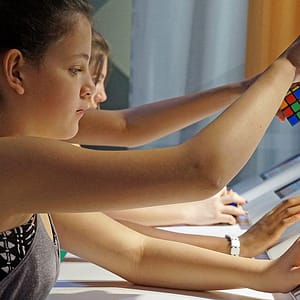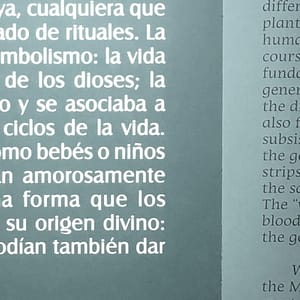Accessibility and Translation
Museums, zoos, botanical gardens, and other cultural institutions continue to roll out new and inclusive resources for visitors with disabilities. Sensory maps, assistive listening devices, braille signage, open captioning, and sign language interpretation are just a few of the accommodations readily available at institutions across the country. Innovative programs address a range of disabilities, from the Smithsonian’s Mornings at the Museum to the Met’s Seeing Through Drawing. By meeting the needs of visitors with developmental and physical disabilities, institutions are sending the message that all are welcome.
Repurposing Content for Visitors With Disabilities
Translation services also provide means of access, although that’s not always what jumps to mind with the term “accessibility.” In fact, accessibility programs and translation services are often viewed as separate resources. However, there are intersections. Accommodating visitors with disabilities does not always require new content. There may be times when assets can be remodeled. Or developed with multiple audiences in mind.
In this talk, Director of Sales Will Lach and Director of Production Yasmin Menon examine a few of the ways in which cultural institutions are strengthening their programming with double-duty accessibility.
Double-Duty Accessibility
meetme: The MoMA Alzheimer’s Project serves as a great example. “It’s sort of what we call double-duty accessibility,” states Will, “because you’re offering it to people who are Spanish speakers and have Alzheimer’s, hitting two audiences.” The comprehensive meetme program, developed for individuals with Alzheimer’s disease and their caregivers includes interviews, research, resource guides, and multimedia content pertaining to MoMA’s overall programming in art and dementia. It is also as a dual-language program, in both English and Spanish.
Linguistic Diversity
Will and Yasmin conclude their talk by addressing the demographics and language use in the U.S. The linguistic diversity in our country may come as a surprise to many. Yet it can play a large factor in an institution’s programming decisions as well as translation strategies.
“A city like Seattle, which has five million people in its metropolitan area, has 170 different languages spoken by people at home,” explains Will, “so, even in the smaller cities in this country, there’s great linguistic diversity.”
Ultimately, institutions want to send the message that all are welcome. We hope you will enjoy the insights Will and Yasmin share, along with the examples they provide to illustrate the efforts museums are making to promote diversity and inclusion.
What Languages Are Spoken in My Community?
Did you know that there were 12,750 Indonesian speakers in the Los Angeles metro area? Or 17,490 Serbian speakers in the Chicago metro?

Languages Spoken at Home in the U.S.
We’ve created a PDF to illustrate the extensive linguistic diversity in the U.S. Along with an outline of the major languages spoken in the country, we provide insights into some of the key metro areas across the U.S.
Download Now"*" indicates required fields
Transcript
Yasmin Menon: Hello and welcome. I’m Yasmin Menon, the Director of Production here at Eriksen Translations.
Will Lach: I’m Will Lach, Director of Sales.
Yasmin Menon: Will, thank you for joining me.
Will Lach: Thank You.
Yasmin Menon: Today, our topic of discussion is “Language Accessibility.” Please describe a little bit about what is being done to provide content and make it accessible to people with special needs and disabilities.
Will Lach: Great question. Many of our clients, The Metropolitan Museum of Art, the Art Institute of Chicago, and the Getty, have been repurposing standard features like the audio tour, turning them into accessibility features for the visitors. For instance, for visitors who are hard of hearing, blind, or have low vision, museums are taking their transcripts, which are also in multiple languages, and offering them to visitors with accessibility issues. So, they’re repurposing these standard features and offering them to visitors with accessibility needs.
Yasmin Menon: That’s really great. They are taking content which is already available and repurposing it for people with disabilities. But, what are institutions and organizations doing to make content for people with disabilities?
Will Lach: Another good question. We had a great program that we did with the Museum of Modern Art (MoMA) a while back, which was called meetme: The MoMA Alzheimer’s Project. From the start, this was a dual language program in English with a version in Spanish. It was fully developed, with PDFs, lesson programs, and subtitled videos—all for people who have Alzheimer’s and want to visit the museum. It’s sort of what we call double-duty accessibility, because you’re offering it to people who are Spanish speakers and have Alzheimer’s, hitting two audiences.
One other example I can bring up is a little further afield from the museum sector, a program we did for Massachusetts General Hospital and Autism Speaks. We translated a program into multiple languages (Arabic, Vietnamese and Spanish) for hospital visitors of children with autism. And that’s a really interesting program that I think museums might want to jump into.
Yasmin Menon: That really sounds great, and it says very loud and clear: all are welcome. We want you to understand what we are offering you very clear. The data about the demographics in this country is also probably pretty staggering. Give us a little overview of that.
Will Lach: There’s a lot of data, thanks to the good old census. For example, there are 240 million people who speak English in the home in the United States. We know that there are 40 million people who speak Spanish in the home in the United States. You drill down a little further, about 15 languages down the list, and you have 470,000 people who speak of Urdu at home. 470,000 versus 40 million seems quite small, but then you realize 470,000 people is bigger than the city of Omaha, Nebraska. Also, 160,000 people speaking Navajo at home is really amazing. I feel very proud to be an American when I realize how multilingual this country is.
Yasmin Menon: That’s what we love.
Will Lach: That’s what we love, and I am going to geek out on you a little bit more. There’s one other stat courtesy of the census: the diversity per metropolitan area. So, take cities like New York: melting pot, Big Apple, Statue of Liberty—20 million people in the greater metro area. There are 200 languages spoken in this city. That’s pretty amazing. It’s not necessarily surprising, though, because it’s New York. What’s fascinating to me is that a much smaller city like Seattle, which has 5 million people in its metropolitan area, has 170 different languages spoken by people at home. So, even in the smaller cities in this country, there’s great lingual diversity.
Yasmin Menon: It really is. It’s great to be a part of all of this. Thanks so much for all of your insights.
Will Lach: Thank you.
Yasmin Menon: Until next time.
Will Lach: Until next time. Bye-bye!
Yasmin Menon: Keep translating!
 Named to the 2024 Inc. 5000 list of fastest-growing companies and ranked among the world’s top 100 language service providers by CSA Research
Named to the 2024 Inc. 5000 list of fastest-growing companies and ranked among the world’s top 100 language service providers by CSA Research

